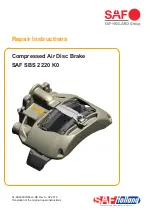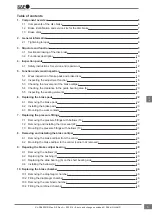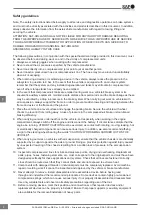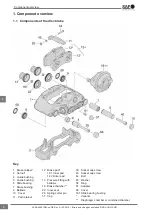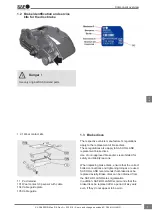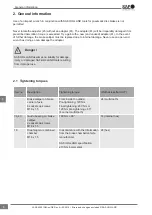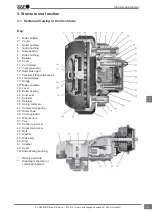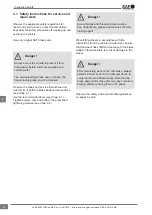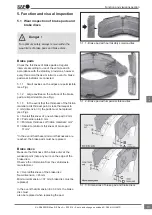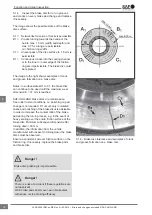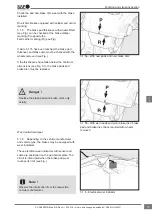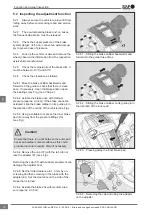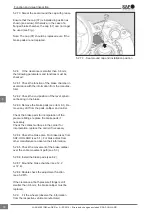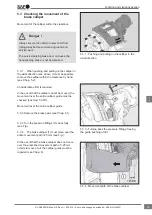
Safety guidelines
Note: The safety instructions listed below apply to all service and diagnostics operations on brake systems
and must not be directly associated with the activities and products described in this document. In addition,
always observe the information from the axle/vehicle manufacturer with regard to towing, lifting and
securing the vehicle.
ATTENTION: SAF-HOLLAND SHALL NOT BE LIABLE FOR ANY INJURY OR DAMAGE RESULTING
FROM THE IMPROPER USE OF SERVICE KITS OR SERVICE TOOLS: IMPROPER USE OF SERVICE
TOOLS AND IMPROPER ATTACHMENT OR APPLICATION OF SERVICE KITS CAN GIVE RISE TO
DAMAGE OR HAZARDOUS HANDLING. SAF-HOLLAND
ASSUMES NO LIABILITY IN THIS CASE.
The following precautions, in conjunction with the special hazard warnings provided in this document, must
be observed before and during work on and in the vicinity of compressed-air units:
1. Always wear safety goggles when working with compressed air.
2. Never exceed the air pressures specified by the vehicle manufacturer.
3. Never look directly into a compressed-air jet or point a jet at another person.
4. Never loosen a pressurised hose or compressed-air line. The hose may move around uncontrollably
when air is escaping.
5. When removing a device or maintaining a device in the vehicle, always reduce the pressure in the
subsystem in question to 0 bar. In the event that the vehicle is equipped with an air-dryer system,
remember that the system and any installed regeneration-air tanks may still contain compressed air,
even if other storage tanks have already been emptied.
6. In the event that compressed-air tanks are emptied during work on a vehicle's brake system or its
pneumatic auxiliary equipment, maintain a safe distance from piston rods and the brake linkage as these
may be actuated by a drop in pressure in the brake system. When carrying out work on vehicles with
air suspension, always support the frame in order to prevent sudden lowering and trapping between the
frame and axles or the frame and the ground.
7. Place the vehicle on a level surface and engage the parking brake. Secure the vehicle with wheel
chocks to prevent it from rolling away. A loss of pressure in the compressed-air brake unit can impair
braking efficiency.
8. When carrying out work underneath or on the vehicle, and especially when working in the engine
compartment, always switch off the engine and disconnect the battery. If circumstances dictate that the
engine be running, UTMOST CAUTION must be exercised as contact with rotating, moving, leaking, hot
or electrically charged components can cause serious injury. In addition, we also recommend affixing
a sign to the steering wheel bearing the words "CAUTION! WORK BEING CARRIED OUT ON THE
VEHICLE!".
9. When carrying out work on vehicles with air suspension, ensure that the vehicle chassis is mechanically
supported by a support opposite the axle or ground. Doing so provides protection against injury caused
by unexpected lowering of the chassis resulting from a sudden loss of pressure in the air-suspension
system.
10. Inspect all compressed-air lines for kinks and pressure points, drying and overheating. Replacement
parts, pipes, hoses, fastening elements, etc. must correspond to the original parts and must have been
designed specifically for these applications and systems. Check that all lines are fastened correctly.
Lines should be routed such that they cannot chafe and are not exposed to extreme heat.
11. Components with damaged threads or individual parts must be completely replaced. Avoid machine
repair or welding work if it cannot be inspected and approved by the vehicle or brake manufacturer.
12. Never attempt to remove, install, disassemble and reassemble a device before having read
through and understood the recommended procedures. Some devices contain highly pre-tensioned
compression springs, which can cause serious injury if not properly disassembled and reassembled.
Use only suitable tools and observe all safety precautions regarding use of the tool.
13. Before removing devices, mark their position and connections so that repaired devices and/or
replacement devices can be properly reinstalled. Ensure that proper supports or auxiliary equipment
are available for the removal/installation of heavy parts.
4
en
XL-SA40001RM-en-DE Rev A • 02.2016 • Errors and changes excluded © SAF-HOLLAND

